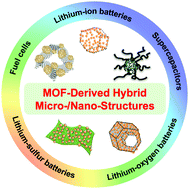Hybrid micro-/nano-structures derived from metal–organic frameworks: preparation and applications in energy storage and conversion
Abstract
Metal–organic frameworks (MOFs), an important class of inorganic–organic hybrid crystals with intrinsic porous structures, can be used as versatile precursors or sacrificial templates for preparation of numerous functional nanomaterials for various applications. Recent developments of MOF-derived hybrid micro-/nano-structures, constructed by more than two components with varied functionalities, have revealed their extensive capabilities to overcome the weaknesses of the individual counterparts and thus give enhanced performance for energy storage and conversion. In this tutorial review, we summarize the recent advances in MOF-derived hybrid micro-/nano-structures. The synthetic strategies for preparing MOF-derived hybrid micro-/nano-structures are first introduced. Focusing on energy storage and conversion, we then discuss their potential applications in lithium-ion batteries, lithium–sulfur batteries, supercapacitors, lithium–oxygen batteries and fuel cells. Finally, we give our personal insights into the challenges and opportunities for the future research of MOF-derived hybrid micro-/nano-structures.



 Please wait while we load your content...
Please wait while we load your content...